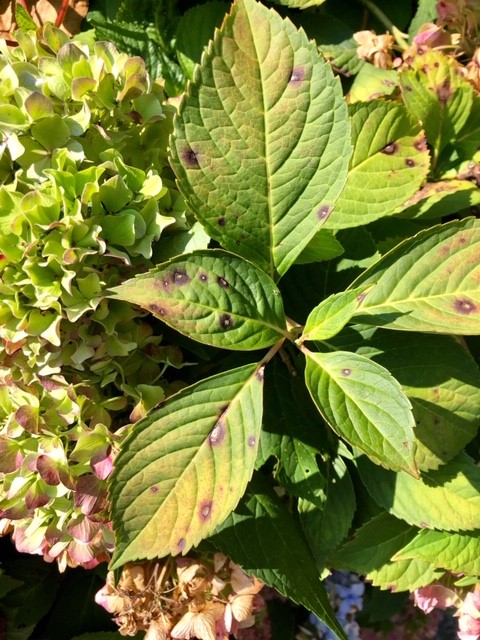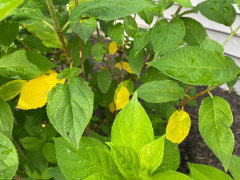The Only Guide to Hydrangea Leaves Turning Yellow
The Only Guide to Hydrangea Leaves Turning Yellow
Blog Article
The Ultimate Guide To Hydrangea Leaves Turning Yellow
Table of ContentsHydrangea Leaves Turning Yellow for Beginners7 Easy Facts About Hydrangea Leaves Turning Yellow DescribedFascination About Hydrangea Leaves Turning YellowNot known Incorrect Statements About Hydrangea Leaves Turning Yellow
Hydrangea plants are recognized for their beautiful blooms, but occasionally their leaves can transform yellow. This is normally an indicator that something is incorrect and the plant needs your assistance.Hydrangea leaves turning yellow can be a cause for problem. Hydrangea leaves commonly transform yellow when the plant is overwatered.
When the origins of a plant are immersed in water for long periods, they start to stifle and rot. This procedure cuts off the origins' oxygen supply, creating the leaves to turn yellow and ultimately pass away. Overwatering can likewise cause other problems such as fallen leave decline, root damage, and fungal development.
If you think your Hydrangea is overwatered, the most effective remedy is to allow the dirt dry completely before watering again. It's also a good concept to inspect the water drainage of your pot or yard bed and make certain that water is not merging around the plant's origins. Hydrangea plants need well-drained dirt to prosper.
Hydrangea Leaves Turning Yellow Fundamentals Explained
You ought to likewise guarantee that you are not watering your Hydrangea too usually. Watering as soon as a week need to suffice, and a lot more commonly if the climate is hot and dry. Hydrangea leaves can also turn yellow if the plant is not obtaining sufficient water. This happens when the plant does not obtain sufficient water, and the dirt starts to dry out.

This is recognized as "fertilizer melt," It happens when the plant's origins are revealed to also much fertilizer. Other signs of plant food shed include brownish or yellow leaves, wilting, and stunted development.
This will certainly assist remove any type of excess plant food from the roots of the plant. It's additionally an excellent concept to minimize the amount of fertilizer you are using. Feeding as soon as a month during the growing season should be sufficient. If you are using chemical plant food, it's finest to make use of one that is watered down and applied according to the producer's directions.
The smart Trick of Hydrangea Leaves Turning Yellow That Nobody is Discussing

If your Hydrangea is infested with parasites, dealing with the plant with neem or horticultural oil is the best solution. It's likewise great to get rid of any affected leaves from the plant (Hydrangea Leaves Turning Yellow).
To avoid spreading out the disease, make certain to sanitize your scissors prior to reducing any kind of leaves off. Hydrangea leaves can likewise turn yellow if the temperature worries the plant. This typically occurs when the plant is exposed to severe cool or warmth. The fallen leaves of the plant will transform yellow and start to drop off.
If the temperature level stresses your Hydrangea, you need to relocate the plant to a location where it will be secured from the extreme cold or heat. You can likewise attempt to offer the plant with some partial shade if exposed to route sunlight. You can also attempt including compost around the plant base to help manage the temperature.
Some Of Hydrangea Leaves Turning Yellow
The fallen leaves can likewise turn yellow if the Hydrangea plant has root rot. This is generally triggered by overwatering or poor drainage. When the plant's origins are submerged in water for as well long, they begin to rot. Among the most usual origin rot signs and symptoms is yellowing fallen leaves, as helpful resources the fungus protects against the roots from absorbing nutrients from the soil.
Various other indicators of origin rot include stunted development, wilting, and leaf decline. Check Visit This Link the origins of your Hydrangea if it has root rot. If they are black or brownish, then they are most likely rotten. If some healthy and balanced origins are left, you can attempt to conserve the plant by replanting it in a new pot with fresh soil.
Water the plant very carefully, making certain not to overwater it. If your Hydrangea is heavily influenced by origin rot, beginning with a new plant is best. All-natural causes can also create yellow hydrangea leaves. The most usual reason is the plant's age. As Hydrangeas age, their fallen leaves will slowly transform yellow and brownish prior to falling off the plant.
You can help the plant by guaranteeing it is obtaining enough water and nutrients. One possibility is that the plant is not obtaining enough water.
Report this page